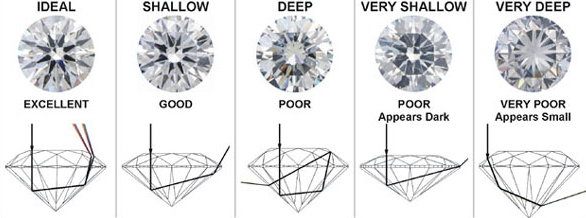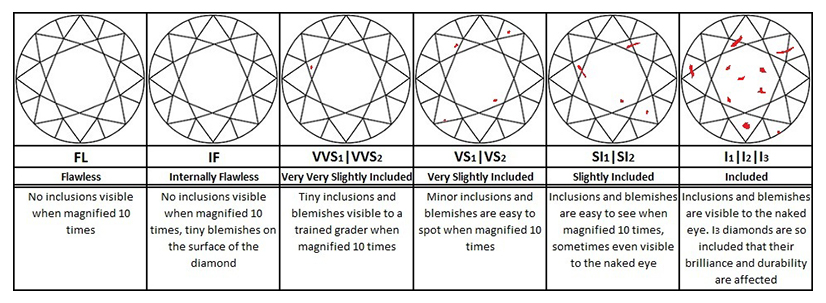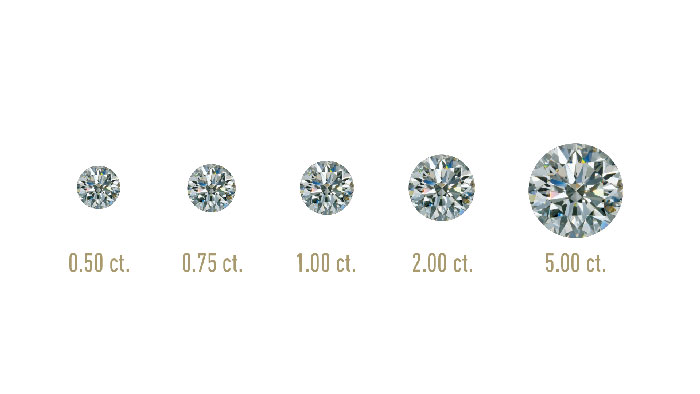The 4 Cs of Diamonds
The 4 Cs, as they are known within the jewelry industry, are the standard way to measure the beauty, craftsmanship and value of a diamond. Find your perfect diamond today!
Diamond Shape
Diamond Cut
Cut is the factor that fuels a diamond’s beauty and is considered to be the most important of the four C’s. Though extremely difficult to analyze, it is important to understand how a diamond achieves its brilliance, fire, and scintillation. There is no single measurement of a diamond that defines its cut, but rather a collection of measurements and observations that determine the relationship between a diamond’s light performance, dimensions, and finish.
There are many laboratories that determine the cut of a diamond. Each laboratory has its own terminology that is used when describing the cut grade of a diamond. GIA describes the cut using a range from Excellent to Poor, while EGL uses terms such as Ideal Plus, and Hearts and Arrows. This grading parameter has only been extended to Round Brilliant cut diamonds at this time. There is no industry standard for ideal or excellent cut diamonds other than Round Brilliant.

Polish and Symmetry are two important factors in the cutting process. Polish refers to the quality of a diamond’s surface, which can include nicks, abrasions, and polish lines. The symmetry grade refers to the alignment of the facets. Examples of poor or fair symmetry characteristics can include an off centered table, misshapen facets, or off center culet. On the GIA scale, the polish and symmetry are graded as follows: Excellent, Very Good, Good, Fair, and Poor. We recommend choosing a diamond with a polish and symmetry grade of good, very good, or excellent.
Since diamonds are formed deep within the earth, under extreme heat and pressure, they often contain unique birthmarks, inclusions or blemishes. Inclusions are internal characteristics within a diamond whereas blemishes are characteristics related to the diamond’s surface. These characteristics can detract from a diamond’s brilliance and overall beauty. When a light vector enters a diamond, it is reflected off the facets and is returned to the eye as pure light. If there is anything disrupting the flow of light in a diamond, such as an inclusion, a portion of light reflected may be lost.
Diamond clarity refers to the absence of these inclusions and blemishes. Diamonds without these birthmarks are rare, and rarity affects a diamond’s value. Every diamond is unique. None are absolutely perfect under 10× magnification. Those that come close are known as flawless diamonds and are exceptionally rare.
On the GIA scale, diamonds are assigned a clarity grade that ranges from flawless (FL) to diamonds with obvious inclusions (I3). In determining a clarity grade, the size, nature, position, color, and quantity of clarity characteristics visible under 10× magnification is taken into consideration.

Though it may seem counterintuitive, a diamond’s color grade actually measures how little color it reflects.
The diamond color grading scale begins with “D” and ranges down to “Z”. A diamond assigned a grade of “D” has absolutely no color – it looks pure white, even to a gemologist inspecting it carefully under 10X magnification. On the other hand, a diamond assigned a grade of “Z” looks yellow or brownish.
Tip: While diamonds in the D, E, or F category reflect the purest white light, it is hard for most consumers to see any color in the G, H, I or J category and it is a safe bet if you plan to set it in yellow or rose gold jewelry, since the warm color of the metal makes any yellowness in the diamond less noticeable. But if you want the purest white diamond, select one of D, E or F and set it in white gold or platinum.

The weight of a diamond is measured in carats, which is a small unit of measurement. Each carat is divided into 100 points. Therefore a 0.50 carat, or a half carat, may be referred to as a 50 point diamond.
Carat weight is the easiest of the 4 C’s for gemologists to determine because of the use of sophisticated measuring equipment. The measurements of a diamond are in direct correlation with its carat weight, if a stone is properly cut. Shallow or deep cut diamonds will not reflect the correct surface area the stone should have.
The carat weight of a diamond has a large impact on the cost. The price per carat increases exponentially with the increase in weight. For example, the value of a 1 carat diamond will be greater than 2 half carat diamonds of equal quality.

14k gold will contain about 58% gold purity, and the rest will be other alloys to strengthen up the gold which contributes to its durability.
18k gold will contain about 75% gold purity. The difference in color between yellow and rose also pertains to the contrast between 14k and 18k gold. 18k in rose gold will contain a pale color finish, and yellow gold will have more of a gold-ish color.
Platinum will be the strongest metal in purest metals. However, it is not as sturdy as gold. Platinum is a denser metal, and it weighs more than gold. Platinum is also softer than gold which therefore makes it more capable of scratching and denting.














